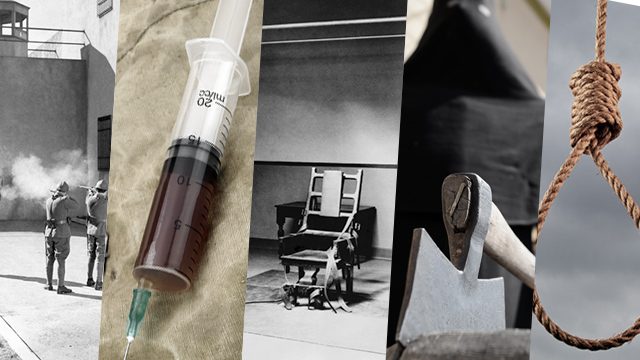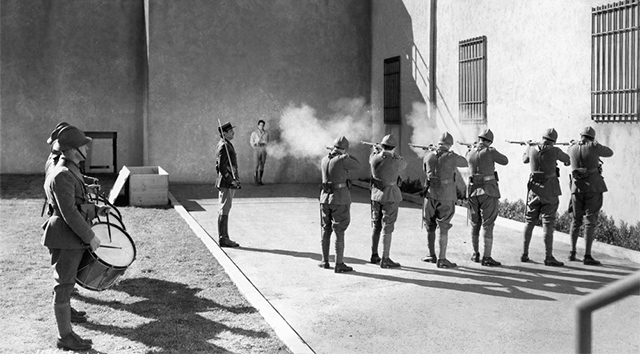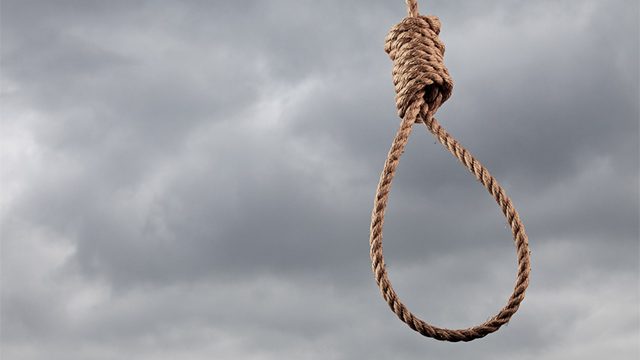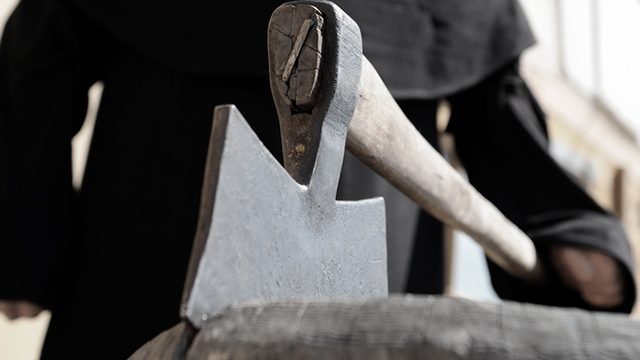SUMMARY
This is AI generated summarization, which may have errors. For context, always refer to the full article.

MANILA, Philippines (UPDATED) – President Rodrigo Duterte asked Congress to reinstate death penalty for “heinous crimes related to illegal drugs and plunder” during his 2019 State of the Nation Address.
Death penalty was outlawed in the Philippines and replaced with life imprisonment and reclusion perpetua (detention of indefinite length, usually for around 30 years) through the passing of Republic Act No. 9346 in 2006.
But in recent years, there have been calls for the revival of capital punishment for heinous crimes.
Filipinos, however, are still vulnerable and sometimes subjected to capital punishment all around the world.
According to Amnesty International, the death penalty still exists in 58 countries.
Rappler takes a look at 20 of these nations and examines the type of death penalties they each observe.

By shooting/firing squad:
Indonesia
The Penal Code of Indonesia states that death-sentenced inmates are to be executed by firing squad, out of public view. The inmate is informed of his or her execution only 72 hours in advance. The inmate can stand or sit, and have his or her eyes covered by a blindfold or a hood. Three of the members of the firing squad are then equipped with rifles loaded with live ammunition, while the other 9 members are loaded with blanks. The squad must then fire from a distance of between 5 and 10 meters. If the inmate still shows signs of life after the shooting, one final shot to the head is administered. (READ: FAST FACTS: Executions in Indonesia)
United Arab Emirates
Although the United Arab Emirates cites stoning as a religiously stipulated punishment under Shari’a law, execution reports suggest that the Emirates only participates in executions by firing squad. The last execution documented in the country was in 2017 for kidnapping, rape, and murder. Although 5 death sentences were imposed, one person was executed.

By hanging:
Malaysia
Malaysia’s Criminal Procedure Code states that death sentences must be carried out by hanging. Pregnant women and children, however, may not be sentenced to death. The country tends to hold executions with great secrecy, without prior or posthumous announcements.
In 2017, at least 4 executions were carried out. The country did not publish any figures but it is likely to be higher. Three of the executions were due to murder, and one for discharging a firearm.
In March 2019, Malaysia announced it will keep denalty penalty but will let lower courts decide whether or not a convicted person will face capital punishment.
Singapore
The Criminal Procedure Code of Singapore cites hanging as its sole method of execution. The country’s last execution was held on March 22, 2019, when a Malaysian was convicted of murder in 2015.
Japan
The Penal Code of Japan cites hanging as the country’s only method of execution. Hanging must take place in an execution site within a penal institution. It may not happen on a weekend or during a public holiday. The date of the execution is kept secret, including to the prisoner and the prisoner’s family. The prisoner is notified of his or her hanging only on the morning of the execution.
In 2018, Japan reached its highest number of executions, 15, out of any given year.
The 13 executed men were members of a doomsday cult, Aum Shinrikyo, who allegedly orchestrated the sarin gas attack in the Tokyo subway in 1995 and conducted more illegal activities.
The other 2 were convicted of murder and were both hung in December 2018
Iraq
Iraq’s Penal Code lists hanging as the country’s main method of execution. The Military and Internal Security Forces laws, however, provide for death by firing squad instead of hanging.
Iraq reportedly executed 58 people in 2018 and typically holds mass executions of more than 10 individuals at a time.
The most recent occurred on June 28, where its prime minister ordered a swift execution of 13 convicted terrorists
Syria
Syria’s Penal Code cites hanging as its method of execution in the case of ordinary persons, while shooting is known to be the method of execution for military personnel.
Its death penalty numbers have not been confirmed due to civil strife, but the most recent execution involved at least 7 by armed execution groups

By lethal injection:
Thailand
Thailand amended its Criminal Code in 2003, changing its sole method of execution from execution by firing squad to execution by lethal injection.
The most recent execution was on June 18th, 2017. The government secretly convicted Theerasak Longji of murder.
Vietnam
In June 2010, Vietnam’s National Assembly voted to replace shooting with lethal injection in the Vietnam Criminal Procedure Code. There was a total of 85 executions reported in the media in year 2018.

By beheading:
Saudi Arabia
The death penalty in the country is entirely dependent on the Shari’ah or Islamic law. According to Amnesty International, beheading or decapitation is normally performed publicly.
Although beheading is the main form of execution, the country also uses stoning to execute individuals who have committed acts such as adultery and has used shooting in the past.
As of July 23, 2019, there have been 122 executions, including 44 foreigners, and 3 women.
Multiple/Other methods of execution:
In Asia:
Taiwan
According to the Ministry of Justice’s Regulations for Carrying Out Executions, executions must be carried out by gunshot or lethal injection. When a prisoner is to be executed via gunshot, the prisoner lies face down on a mattress on the floor and is shot from behind 3 times at close range after a medical practitioner marks where his heart is. Families are informed of the executions only afterwards, when they are called to collect the prisoner’s body.
In August 2018, Taiwan executed Lee Hung-chi, who was convicted for murdering his wife and child in 2014 – marking the first execution in two years.
China
Although the Chinese government does not release the number of executions it carries out, a 2014 report from Amnesty International estimated that thousands of criminals are executed and sentenced to death in China every year.
China’s main form of execution is through lethal injection as shooting executions were discontinued in 2010. Executions are considered a “state secret,” but Amnesty International estimates that thousands are executed yearly.
The last known execution was for 10 people found guilty of drug-related crimes in June 23, 2018.
India
Although hanging is listed as India’s preferred method of execution in the Indian Criminal Procedure Code, the country’s 1950 Army Act also lists shooting as an official method of execution in the military court-martial system.
Its last execution was held in 2015, when Yakub Memon was convicted for financing the 1993 bombings in Mumbai
North Korea
The North Korea Criminal Code cites execution as the “extinguishing of bodily life,” therefore, the country does not distinguish among specific methods of execution. In March 2019, a public execution occurred, in which 2 fortune-tellers were accused of conducting “superstitious activities” and shot by a firing squad
Iran
Iran has been known to use several methods of execution including hanging, shooting, beheading and stoning. Despite a 2008 judicial moratorium on public executions, hangings are still often made public.
Used in 2008, judges sometimes sentence an individual to be thrown from a cliff or other form of height.
According to the Iran Human Rights Monitor, 115 people have been executed in 2019. Amnesty International reported the secret execution of 2 underage males, who were convicted when they were 15 on rape charges.
Kuwait
The Kuwait Penal Code lists both hanging and shooting by firing squad as the country’s methods of execution. In April 2013, 3 men – a Pakistani, a Saudi, and a stateless Arab – were hanged for acts of murder. In January 2017, 7 people – including a member of a royal family and a Filipino – were hanged.
In other parts of the world:
Egypt
The Egypt Penal Code states that any person sentenced to capital punishment must be hanged. Its last execution was held in 2019, when nine men were convicted for killing the country’s former public prosecutor in 2015.
United States of America
Many states use several methods of execution, including lethal injection, electrocution, gas chamber, hanging and firing squad. But states such as New Mexico and Connecticut have already abolished the death penalty. As of June 20, 2019, 10 prisoners have been executed, 4 being of African-American descent
Ethiopia
The country’s Criminal Code bars public hanging and other inhuman methods of execution. The method of execution, however, can still be determined by the executive body responsible for administration of the prison where the execution will be held. The country’s last execution was held in August 2007, when a major in the Ethiopian army was executed by firing squad for murdering the head of the intelligence and security services in 2001.
Botswana
The Penal Code of Botswana specifies that prisoners sentenced to death must be hanged by the neck. The Botswana Defense Force Act, however, allows the president to determine the prisoner’s manner of execution. The country’s last execution was held on May 2018, when Uyapo Poloko was convicted of murder. – Rappler.com
SOURCES: Amnesty International, Death Penalty Worldwide
Photos of noose, firing squad, lethal injection, electric chair, and executioner from Shutterstock
Alexandra Bichara was a Rappler intern in 2015. Amelie de Leon is a Rappler intern from the International School Manila..
Add a comment
How does this make you feel?
There are no comments yet. Add your comment to start the conversation.